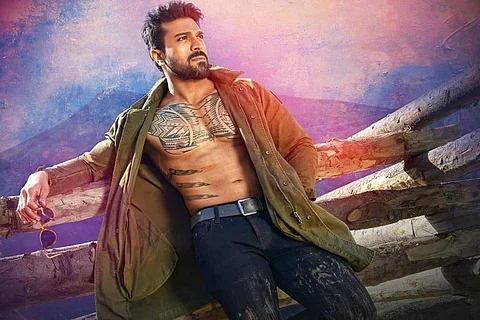

Vinaya Vidheya Rama is a movie so bad, you should get a tetanus injection after watching it. The film isn’t even a commercial extravaganza of the sorts that Telugu audiences are already used to. It is a truckload of randomly shot scenes mixed together without head or tail, almost like a go-figure puzzle you are supposed to solve with the background sound of a thousand Indian politicians debating on news channels.
It is hard to imagine how the script was narrated to the producers – four happy-family enjoying with full-overaction scenes, 25 fights scenes with hundreds of men flying, four Vivek Oberoi looking angry shots, 50 Ram Charan looking angry shots, two Ram Charan without-shirt macho closeups, two lecherous heroine closeups, one women-crying long shot, 20 random-people-flying shots, a couple of duets with hundreds of extras dancing in uniforms, five children-happy-with-their-uncle shots.
The gibberish gives us many gems but sample this - somewhere near the Bihar-Nepal border, surrounded by hills Bhuvan Kumar (Prashanth), an election officer, who has already witnessed dozens of his officers being shot dead, warns Raja Bhai (Vivek Oberoi). Meanwhile the youngest of the five orphans brought up together, Rama (Ram Charan) is about to board a flight. He is returning from Gujarat, with the rest of his family – women and children, even as three of his brothers, who are civil servants working together all the time (don’t ask how they manage to get postings together, everywhere) are now being smashed to pulp by Raja Bhai. Bhuvan Kumar runs amok, dodging hundreds of bullets, to get phone signal, so he can call Rama to come and finish Raja Bhai, who is the ‘scum of the society’.
Rama realises his brother is in danger, leaves the airport, jumps from some overhead bridge on to a train, rides a horse, kills 300 of Raja Bhai’s men on the way to the Nepal border, and finally reaches the area from where he received the call – his brothers are still in the same kneeling position. Interstellar 2.0.
After much dialogue-delivery, he almost kills Raja Bhai; almost, because how else will there be a revenge-climax?! And how else will we enjoy scenes like the one where a poisonous snake bites Raja Bhai four times and dies – because Raja Bhai Munna is the real shizz.
In Boyapati Srinu’s mind-numbing, melodramatic movie, timelines don’t matter; distances don’t matter. Continuity doesn’t matter. Hell, we could be watching parallel universes in a Marvel movie, with terrible visual effects, head-splitting background music and over-dramatic acting. That Rama, the youngest of the five brothers, has dedicated his life to the family – literally, he is not interested in doing anything but taking care of his family while his brothers slog away as top-notch civil servants – and is pampered by all his sisters-in-law, is in itself a premise so illogical you will want to shoot yourself in the head. The family is always happy and laughing and having fun in their palatial bungalow while eating from the same plate and dressing up in beautiful clothes for songs. The men work, and the women take care of the house. Such happy, much love! The movie could be summarised in probably one line – two elections, one election officer with a superhero brother and thousands (not exaggerating) of dead goons.
In between, there is Sita (Kiara Advani), whose marriage is ‘arranged’ with Rama. Her mother (Hema) is a women-empowerment activist. The filmmaker’s myopic idea of a woman activist is someone who tells her future son-in-law (who is good at bashing people up and not much else if we believe the movie) how to take care of her daughter, and beats up men who have harassed women. The heroine entry involves the camera panning from top to bottom as Kiara jogs on the treadmill. How do the crew manage such crass voyeurism and not feel awkward is a question that frequently occurs to me!
The movie’s editing leaves you wondering if you are watching a film made by the amnesiac protagonist of Ghajini/Memento. The editor Kotagiri Venkateswara Rao is a 6-time Nandi Award winner. And yet, here’s the balderdash we are dished out: a corrupt encounter specialist transports the entire family of Rama from Hyderabad to some remote location, so someone can take revenge on them. Next thing we know, Rama is bashing up Raja Bhai’s goons (how did they turn up, one villain crashing another villain’s revenge party), from where, we go into a flashback of why Raja Bhai’s goons are getting bashed up, from where we are transported into another parallel narrative where Ram Charan and Kiara Advani are dancing to a duet. Sneha (such a good actor reduced to this) makes an appearance in between all this and before we know it, we're in the midst of chopped heads.
Devi Sri Prasad gives us the usual – put percussion and two three old songs in a mixer, recycle and boom, new song. But what stands out is that the director needed Vivek Oberoi, Mukesh Rishi and Mahesh Manjrekar, each for four scenes, to make the hero look good. What egos! Someone’s been high on something-that-must-not-be-named here.
All in all, VVR is a movie that will make you question your life choices, and the kind of inane, featherbrained decision-making process that has landed you in the movie hall. Save yourself!
Disclaimer: This review was not paid for or commissioned by anyone associated with the film. Neither TNM nor any of its reviewers have any sort of business relationship with the film's producers or any other members of its cast and crew.